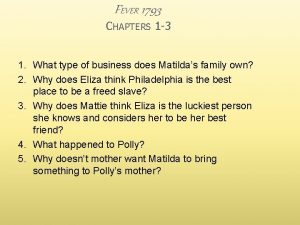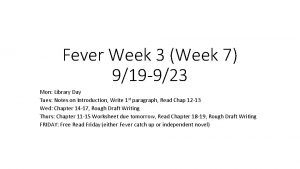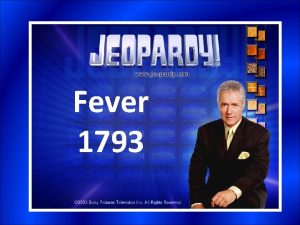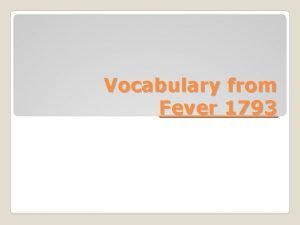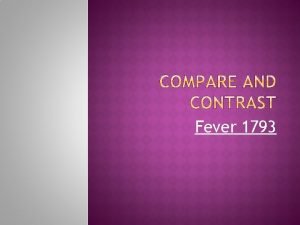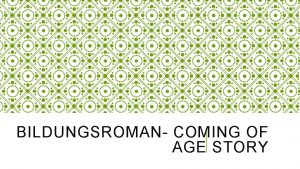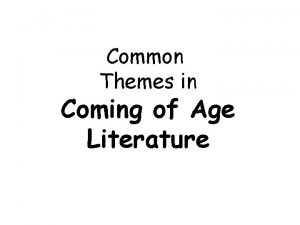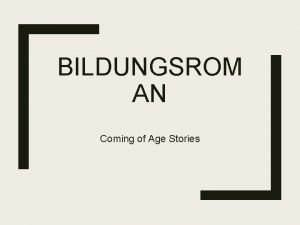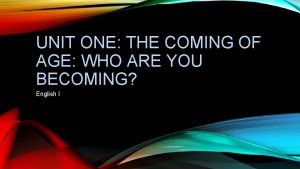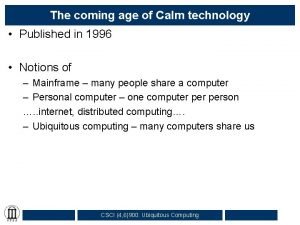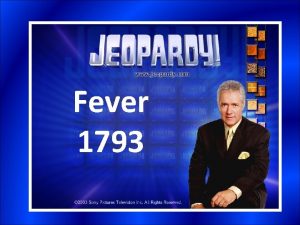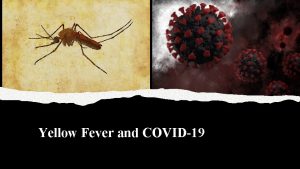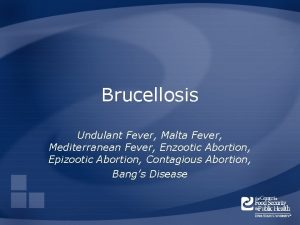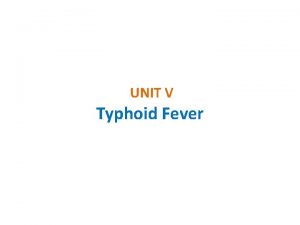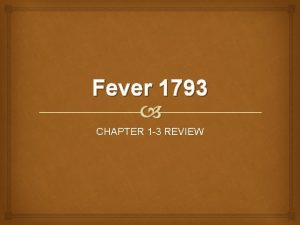Fever 1793 Coming of age is often a















- Slides: 15

Fever 1793

� Coming of age is often a topic of fiction, in the form of a coming-of-age story. � In literature, a novel which deals with the psychological and moral growth associated with coming of age is called a bildungsroman. � Similar stories told in film are called comingof-age films.

� bil·dungs·ro·man: noun ˈbil-du ŋ(k)s-rō- ˌmän, -du ŋz- � Definition of BILDUNGSROMAN: a novel about the moral and psychological growth of the main character � Origin of BILDUNGSROMAN: German, from Bildung education + Roman novel � First Known Use: 1910

� Dynamic characters change during the course of the story. �Outlook on life �Compassion toward people �Attitudes toward responsibility �Purpose in life �Relationships with other people �Morals �Selfishness vs. selflessness �Etc. � Static characters remain the same during the course of the story.

� � Mattie was a dynamic character in the novel Fever 1793 was a coming of age story as well as an example of historical fiction. You will compare and contrast the personal qualities of Mattie before and after the yellow fever epidemic of 1793 in order to illustrate how she was a dynamic character. Possible comparison points include the following. You will choose four points of comparison: one relationship and three other points. Relationship with mother � Relationship with grandfather � Relationship with Eliza � Relationship with Nathaniel � Attitude toward work � Outlook toward the future � Methods of making decisions � Areas of responsibility � Motivation �

� This type of essay is one in which you take two or more subjects and look at the similarities and differences of each. � Compare and contrast essays require research and close text examination in order to provide details. � Compare and contrast essays always have a purpose – they make a point!

�A compare/contrast essay must serve some sort of purpose by making a point. This point is thesis statement. � A thesis statement… �States the main point of your argument �Clarifies something unknown or not well understood. �Leads to a fresh insight or a new way of viewing something. �Brings one or both of the subjects into sharper focus.

� Introductory paragraph � Introduce Mattie in the context of the novel � Introduce your thesis statement � Give an overview of what criteria you will use points � Restate your thesis in another way � for comparison In the 2 body paragraphs � In the first body paragraph, talk about Mattie before the yellow fever in reference to each of the 3 comparison points. Cite textual evidence for each statement you make. � In the second body paragraph, talk about Mattie after the yellow fever in reference to each of the 3 comparison points. Cite textual evidence for each statement you make. � Conclusion paragraph � Generalize the evidence given in the body paragraphs � Based on the evidence you gave in the body paragraphs, draw a conclusion that focuses on the main thesis or point of your paper

� Introductory paragraph � Introduce Mattie in the context of the novel � Introduce your thesis statement � Give an overview of what criteria you will use points � Restate your thesis in another way � for comparison In each of the 3 body paragraphs � Use one paragraph for each of � Write about Mattie before the 3 comparison points yellow fever and Mattie after the yellow fever in reference to each comparison point � Cite textual evidence for each statement you make and include parenthetical citations for page numbers(Anderson 3 -4) � Conclusion paragraph � Generalize the evidence given in the body paragraphs (summary of your points) � Based on the evidence you gave in the body paragraphs, draw a conclusion that focuses on the main thesis or point of your paper

� Choose the criteria for comparison (specific points or criteria that you will focus on for the paper) � Create a thesis statement (a statement of fact that summarizes the main point of the essay � Choose an organization pattern for the body paragraphs (point-by-point or block arrangement)

� Complete �"I the following statements: am comparing Mattie before and after the yellow fever epidemic in order to make the point that __________________. ” �“I will compare Mattie before and after the yellow fever epidemic in relation to the following comparison points____________, _______. ” �“I will use the following organizational structure for my essay_______________” �"The similarities and differences I discover relate to the essential meaning of the novel because _____________________.

� Complete the Compare/Contrast Essay outline sheet � Include page numbers of textual evidence for any statement that you make

I. Introductory paragraph II. Body Paragraph 1 III. Body Paragraph 2 IV. Body Paragraph 3 V. Conclusion

Researchers place brief parenthetical descriptions to acknowledge which parts of their paper reference particular sources. Generally, you want to provide the last name of the author and the specific page numbers of the source. If such information is already given in the body of the sentence, then exclude it from the parenthetical citation. � Place the parenthetical citation where there is a pause in the sentence – normally before the end of a sentence or a comma. The in-text citation will differ depending on how much information you provide within the sentence. � Example: � Johnson argues this point (12 -13). � This point had already been argued (Johnson 12 -13). �

 Fever 1793 chapter 24
Fever 1793 chapter 24 Fever 1793 chapter 11-15 answers
Fever 1793 chapter 11-15 answers Fever 1793 summary
Fever 1793 summary Plot diagram for fever 1793
Plot diagram for fever 1793 Fever 1793 vocabulary
Fever 1793 vocabulary Fever 1793 essay
Fever 1793 essay Fever 1793 themes
Fever 1793 themes Iron age dates
Iron age dates Iron age bronze age stone age timeline
Iron age bronze age stone age timeline Bildungsroman short story
Bildungsroman short story Coming of age themes
Coming of age themes An coming
An coming Thematic statement
Thematic statement Vanuatu coming of age tradition land divers
Vanuatu coming of age tradition land divers Coming of age unit
Coming of age unit The coming age of calm technology
The coming age of calm technology
